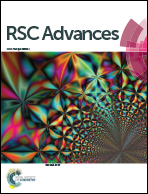In situ growth of silver nanowires on reduced graphene oxide sheets for transparent electrically conductive films
Abstract
In situ growth of silver nanowires (AgNWs) on the surface of functionalized-graphene (rGO) nanosheets is achieved through a synchronous reduction of graphene oxide and silver ions using sodium citrate as the chemical reduction agent in the presence of poly(diallyldimethyl ammonium chloride). The prepared AgNW–rGO hybrids are characterized by zeta potential, X-ray diffraction, Raman spectroscopy, transmission and scanning electron microscopy, atomic force microscopy, respectively. The stable AgNW–rGO aqueous solution is readily used to fabricate highly transparent, flexible and conductive films. The AgNW–rGO/PVA films show an electrical conductivity of 19.5 S m−1 with 67.7% light transmittance at a wavelength of 550 nm.


 Please wait while we load your content...
Please wait while we load your content...